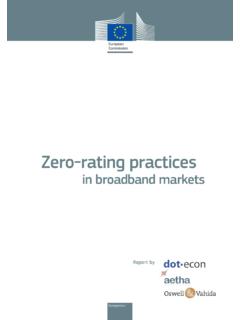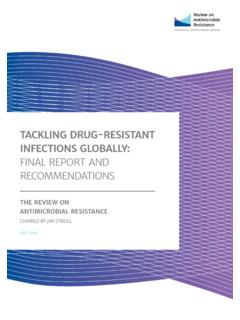Transcription of Merger Remedies Study - European Commission
1 Merger Remedies Study Public version DG COMP, European Commission October 2005. DG COMP - Merger Remedies Study public version Notice on the public version This is the public version of the Study . It is essentially identical with the DG COMP internal confidential version, except for the following points: 1) All references to cases, relevant markets, economic sectors, and particular Remedies are removed. For the 40 cases, random numbers are attributed. They are mentioned in the Study as c1 c40. For the 96 Remedies , random numbers were attributed and they are referred to as r1 r96. 2) All case descriptions in the text (in boxes) are anonimised by replacing all company names, relevant markets, definitions or any other information that may reveal the identity of the case, the remedy or the parties by [ ].
2 In some of these descriptions also the case or remedy references had to be replaced by [ ] . 3) Annexes 2 and 3 containing the lists of analysed cases are removed, as is Annex 9 which includes more detailed case descriptions. These changes were carried out in accordance with the confidentiality assurances made to participating companies (see Annex 4: Model contact letters with confidentiality assurance, p. 177). - Page 2 - DG COMP - Merger Remedies Study public version The Study was entirely carried out in-house by DG COMP staff. This final report is therefore a DG COMP staff paper, setting out the findings of the Study .
3 It does not represent the views of the European Commission . The Study was carried out and the final report was prepared by the following Commission staff: Authors: Alex KOPKE, Katharina KRAAK, Damien LEVIE (DG ENTR), Justin MENEZES, Sandra PLAS, Walter TRETTON. Editors: Thalia LINGOS, Nadia de SOUZA. Case teams for interviews: Csilla BARTOK, Kris BOEYKENS, Monika CHLEBOWSKA, Flavien CHRIST, Adela GOMEZ, Alex KOPKE, Katharina KRAAK, Jean-Pierre LABE, Damien LEVIE, Thalia LINGOS, Justin MENEZES, Sandra PLAS, Nadia de SOUZA, Walter TRETTON. Minutes of interviews: Hendrik ACKER, Evelyn BARLOW, Nicolas BESSOT, Luis BLANQUEZ, Cristina CRESPO, Ivan GUROV, Anna-Bettina KAISER, Katharina KRAAK, Maria OULI, Elisabet POVEDA, Sonia RAMOS MOURA, Andreas SCHNEIDER, Alexander WALLAU, Andrea ZENISEK.
4 Stocktaking: Hendrik ACKER, Csilla BARTOK, Julia BEHRENDT, Nicolas BESSOT, Claudia BRANDT, Julia BROCKHOFF, Ivan GUROV, Mariann JENSEN, Anna-Bettina KAISER, Alex KOPKE, Marc LAUTERFELD, Ewelina LESZCZAK, Viktor LUSZCZ, Elisabet POVEDA, Andr RIZZO, Andreas SCHNEIDER, Igor TACCANI, Ioannis VIRVILIS, Georg WEIDENBACH. - Page 3 - DG COMP - Merger Remedies Study public version TABLE OF CONTENTS. I. INTRODUCTION 10. A. Background and objectives of the Study 10. B. Methodology 11. 1. Selection of a representative sample of cases and Remedies 11. 2. Interview methodology 14. 3. Limitations of the methodology 16. C. Typology used in this Study to classify Remedies 17.
5 D. Types of analysed competition concerns and theories of harm 20. E. Organisation of this Study 22. II. IMPLEMENTATION OF COMMITMENTS TO TRANSFER A MARKET. POSITION AND OF COMMITMENTS TO EXIT FROM A JV 23. A. Scope of the divested business 23. 1. Serious issues regarding the scope of the divested business 23. 2. Effectiveness of Remedies of different scope 33. 3. Scope and purchaser approval 40. 4. Description of the scope of the divested business in the commitments 42. 5. Transitional agreements 44. B. Remedies that directly affected third parties 46. 1. The influence of third parties on the implementation of Remedies 47.
6 2. Remedies where third party implementation issues were avoided 50. 3. Overall findings 51. C. Alternative divestiture commitments and crown jewels 52. 1. Current practice of alternative divestiture commitments 52. 2. Infrequent use of alternative divestiture commitments in the analysed Remedies 52. D. Interim preservation and holding separate of the divested business 56. 1. Length of the interim period 56. 2. Preservation of viability, marketability and competitiveness 56. 3. Hold-separate provisions and ring-fencing obligations 59. 4. Monitoring by a trustee 61. 5. Specific trustee function: replacement of board members 65.
7 6. Hold-separate managers 66. E. The divestiture process 68. 1. Information available to purchasers 68. 2. Strategic behaviour of sellers and purchasers 70. F. Carve-out of the divested business 73. 1. Separation of assets 73. 2. Findings on shared assets 74. - Page 4 - DG COMP - Merger Remedies Study public version 3. Findings on the allocation of personnel 76. 4. Responsibilities of the committing parties 76. 5. The role of the trustee 77. 6. Role of the hold-separate manager 79. G. Transfer of the divested business 80. 1. Transfer of tangible assets 81. 2. Transfer of intangible assets 81. 3. Transfer of personnel 84.
8 4. Transitional economic performance provisions 84. 5. The role of purchasers in the transfer process 85. 6. Monitoring the transfer process 86. H. Monitoring trustees 87. 1. The timing of the appointment of the trustee 88. 2. Suitability of monitoring trustees 90. 3. The trustee's mandate and its relationship with various stakeholders in the process 94. I. Suitable purchasers 98. 1. Purchaser requirements 99. 2. Proven expertise 99. 3. Financial resources 102. 4. Incentives to compete actively 102. 5. Independent and unconnected purchaser 105. 6. Unlikeliness of creating new competition problems or delays in implementation 106.
9 7. Up-front buyers 107. J. Divestiture deadlines 109. 1. Current practice 109. 2. Divestiture deadlines provided for in commitments to transfer a market position 110. 3. Actual implementation periods of commitments to transfer a market position 111. 4. Divestiture periods in commitments to exit from a JV 112. III. IMPLEMENTATION OF COMMITMENTS TO GRANT ACCESS AND OTHER. COMMITMENTS 114. A. Access commitments 114. 1. Access to infrastructure 115. 2. Access to technology or IPRs 116. 3. Termination of exclusive relationships 120. B. Other commitments 121. 1. Commitments to sever influence in a competitor 121. - Page 5 - DG COMP - Merger Remedies Study public version 2.
10 Collective dominance-specific commitments 122. 3. Other commitments 123. IV. EFFECTIVENESS OF THE ANALYSED Remedies 124. A. Summary of the number and types of serious design and/or implementation issues 124. 1. Commitments to transfer a market position and commitments to exit from a JV 124. 2. Access Remedies and other Remedies 127. B. Market indicators 127. 1. Divested business still operating in the market 128. 2. Market share evolution of the divested business 129. 3. Market share evolution of the retained business 130. 4. Comparison of the market share evolution of the retained and divested businesses 130. 5. Purchasers' own assessment 131.
















